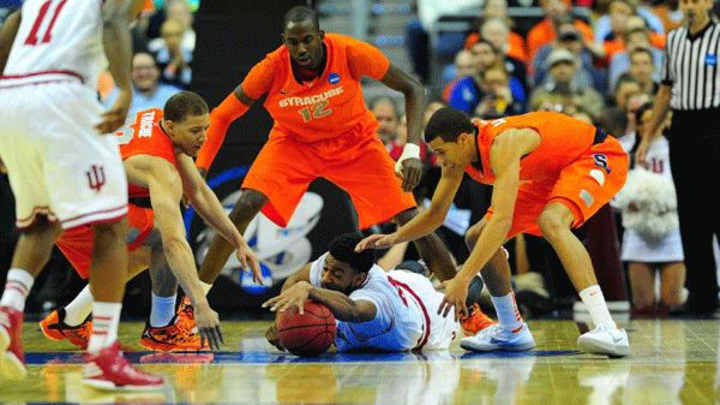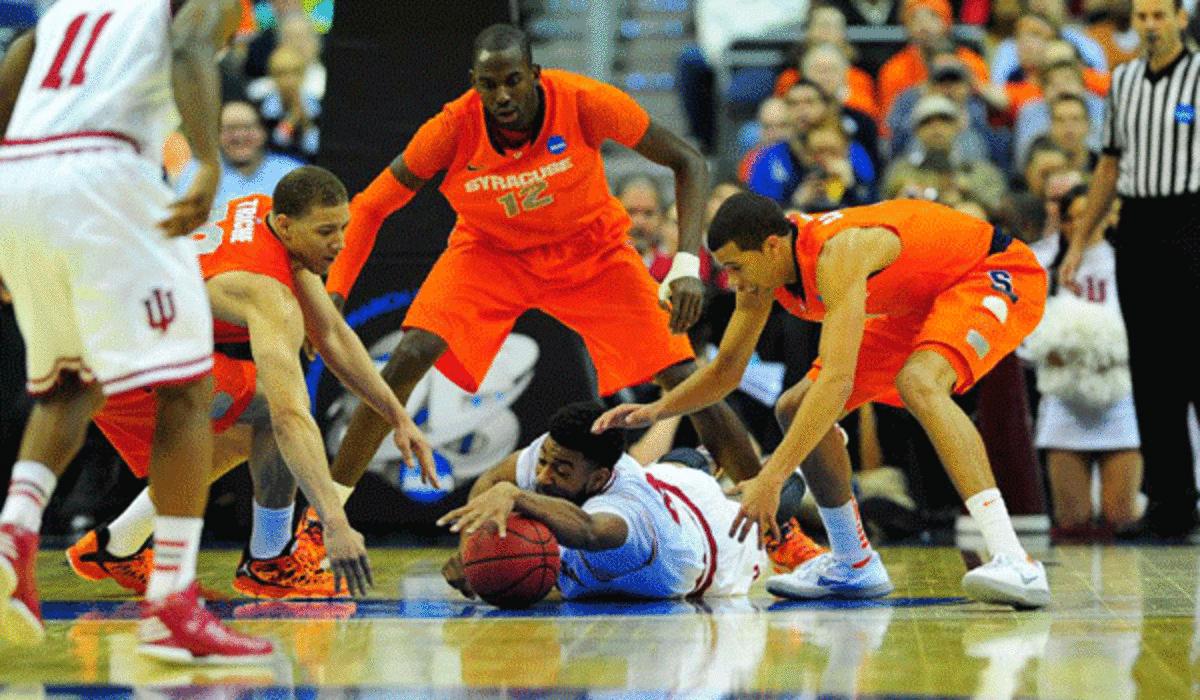Zone Helps Syracuse Orange Sink Overmatched Indiana Hoosiers In Sweet 16

Syracuse's zone defense pushed the Orange ahead by as many as 18 points in the first half vs. Indiana. (SI)

WASHINGTON D.C. – The shootarounds of Indiana and Syracuse on Wednesday afternoon offered prescient insight into each program. Syracuse lollygagged through a free and easy dunk contest, while Indiana coach Tom Crean ordered his team through drills with clinical precision and incessant yelling.
The Orange barely broke a sweat. The Hoosiers engaged with laser focus.
And in the Round of 16 on Thursday night, Syracuse came out free and loose, its zone suffocating, its offense flowing and the team playing harder than it had all year. Indiana came out tight and sluggish, staring at Syracuse's 2-3 zone like a Latin test it hadn't prepared for.
And in the end, Syracuse crushed the Hoosiers, 61-50, firing out to an 18-point lead and keeping Indiana at a safe distance the rest of the game. Syracuse will play league-foe Marquette for a shot at the Final Four on Saturday. The Orange lost at Marquette, 74-71, amid a season-ending slide of losing four of five when the Final Four appeared to be something this team would be watching on television back on South Campus.
The upset wasn't that the talented No. 4 Orange topped the No. 1 Hoosiers. The surprise came in the relatively easy manner in which Syracuse disposed of Indiana, which looked overmatched on the court and the sideline.
The goats for Indiana were as notable as the heroes for Syracuse. Cody Zeller disappeared amid the overwhelming length of Syracuse's zone, scoring just 11 points on 3-for-10 shooting. Indiana's pint-sized guards Jordan Hulls and Yogi Ferrell combined to score zero points on 0-for-7 shooting, looking like jayvee players called up to the varsity, unaccustomed to the size and speed.
Michael Carter-Williams, who went into a deep funk late in the season, led the Orange with a team-high 25 points. Brandon Triche scored 13 and C.J. Fair chipped in 10.
After Indiana cut the lead to six early in the second half, Syracuse responded with a 6-0 run and was never really threatened again.
The Orange upset could be summed up in one flurry with about nine minutes remaining in the second half. Carter-Williams darted down the lane for a lay-up that he seemed to bank in with two hands, like a mid-air soccer throw-in. He followed that with a dagger three-pointer at the top of the key, free and easy, to go up 51-37 and essentially ice the game. On the other end, Indiana looked like it had finally found a crevice in Syracuse's 2-3 zone. But Will Sheehey's dunk attempt got swatted away by Jerami Grant, and while Crean screamed for a foul, Sheehey ran down the court wondering where Grant game from.
That was the story for Indiana, lost amid the trees of Syracuse's zone. There was always a hand to tip a pass, a double team to trap and a long arm to alter or block a shot.
Indiana entered the game as one of the tournament's heavy favorites but faced an odd matchup disadvantage that led to its biggest halftime deficit of the season. Unable to penetrate or dissect Syracuse's zone, the Hoosiers fell behind by 18 before clawing back to 34-22 at halftime.
During conference play, the Hoosiers saw zone less than 15 percent of the time, according to Sheehey, and that was mostly Northwestern's 1-3-1 zone defense, a much different prep than Syracuse's long-limbed 2-3 zone. (They played Northwestern just once, though Michigan flashed a 1-3-1 at times.)
In the heartland, man-to-man is still as prevalent as corn fields. And while Bob Knight would smile at that notion, he'd have likely thrown a chair at how lost the Hoosiers looked in the game's first half.
Syracuse tipped passes, blocked shots and a forced a shot-clock violation. And that was all in the first three minutes. Indiana spent most of the first half plodding instead of playing, the Orange defenders looming as much in their heads and in their face.
The best evidence of Indiana being overwhelmed by the zone came from its inability to get the ball to Zeller, who didn't take a shot for the game's first 12 minutes. Indiana turned the ball over 11 times in the game's first 13 minutes, missed its first six three-pointers and spent most of the half lunging for loose balls it had fumbled in the offensive end.
It took Indiana six minutes to score its first field goal, 10 minutes to score its second and it didn't hit a three-pointer until 18:30 passed.
